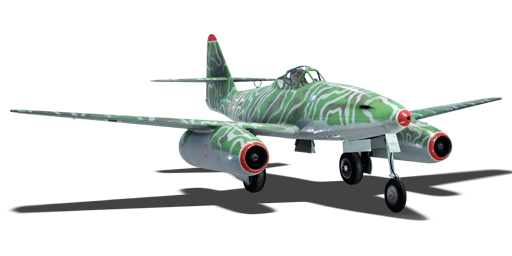

Aviation
Me 262 A-2a
V
Rank
AB
6.7
RB
6.7
SB
6.7
Battle rating
Germany
Research country
Strike aircraft
Main role
General information
Where to purchase
Camouflages
Flight performance
Max speed
at 6,000 m
865796910824 km/h
Rate of Climb
2014.724.715.8 m/s
Turn time
2829.926.929.1 s
Max altitude
12,500 m
Takeoff Run
750 m
Landing
flaps
flaps
Take-off
flaps
flaps
Combat
flaps
flaps
Air
brake
brake
General characteristics
Crew
1 person
Engine
Length
10.6 m
Wingspan
12.5 m
Wing Loading
282 kg/m²
Weight:
Base weight
4.24.334.094.31 t
Fuel in main tanks
1.95 t (53m)
Limits:
Max Speed Limit (IAS)
1,050 km/h
Mach Number Limit
0.95 M
G limit
≈ -5/11 G
Flap Speed Limit (IAS)
L / T / C
380 / 529 / 558 km/h
Gear Speed Limit (IAS)
450 km/h
Offensive armament
2 × 30 mm MK 108 cannon
Ammunition
160 rounds
Fire rate
600 shots/min
One-second Burst Mass
3.3 kg
| Belt | Belt filling | Armor penetration (mm) at a distance: | |||||
|---|---|---|---|---|---|---|---|
| 10 m | 100 m | 500 m | 1000 m | 1500 m | 2000 m | ||
| HEI-T/I | 6 | 6 | 6 | 6 | 6 | 6 | |
| HEI-T/HEI-T/HEI-T/HEF-I | 4 | 4 | 4 | 4 | 4 | 4 | |
| HEI-T/HEI-T/HEI-T | 4 | 4 | 4 | 4 | 4 | 4 | |
| HEI | 4 | 4 | 4 | 4 | 4 | 4 | |
Suspended armament
Setup 1
24 × R4M rockets
Setup 2
2 × 250 kg SC250JA bomb
Setup 3
500 kg SC500K bomb
Economy
Repair cost
Basic → Reference
AB
3,926 → 4,974 

RB
7,083 → 8,974 

SB
9,836 → 12,462 

Crew training
86,000 

Experts
300,000 

Aces
1,700 

Research Aces
720,000 

Reward multiplier
AB / RB / SB
120 / 250 / 600 % 

196 % 

Total cost of modifications
91,100 

147,000 

Talisman cost
2,100 

Flight performance | |
|---|---|
Survivability |
|---|
Weaponry | |
|---|---|
Rating by players
You must play more than 3 battles for the last week and more than 10 battles in a vehicle to rate it.
Like:
52
Flight performance:
Not enough ratings
Survivability:
Not enough ratings
Aerial combat:
Not enough ratings
Ground attack:
Not enough ratings
Balance:
Not enough ratings
Tips & Tricks
This space is currently empty
Do you know any interesting vehicle features?
Loading...
No articles about this vehicle yet
Become the first author and get rewards!
Write a guide, tell about interesting historical facts, make a tutorial or simply an interesting post.
No more content